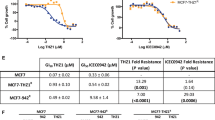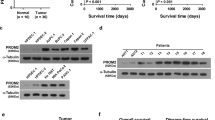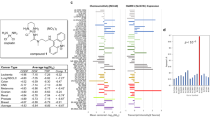Abstract
Overexpression of P-glycoprotein (PGP), MRP or LRP has been characterized as the ‘proximal’, while overexpression of the anti-apoptosis Bcl-2 or Bcl-xL relative to the pro-apoptosis Bax protein has been recognized as the ‘distal’ mechanism of multidrug resistance in human AML cells. In the present studies, we examined whether these mechanisms can co-exist in human AML HL-60 cells. We also determined how these mechanisms would affect the accumulation and cytotoxicity of a PGP substrate, such as Taxol (paclitaxel). For this, immunoblot analyses were performed to determine the expression of PGP, MRP, Myc, Bcl-2, Bcl-xL and Bax on either the multidrug-resistant HL-60 sublines created under the selection pressure of doxorubicin (HL-60/AR), paclitaxel (HL-60/TAX1000) or vincristine (HL-60/VCR), or sublines created by transfection and overexpression of the bcl-2 (HL-60/Bcl-2) or bcl-xL gene (HL-60/Bcl-xL). As compared to the control HL-60, HL-60/AR cells possess high MRP while HL-60/TAX1000 and HL-60/VCR cells express high levels of the mdr-1 encoded PGP. In addition, these multidrug-resistant cells possess 1.5- to 2.5-fold higher Bcl-2, while their Bax and Myc levels are similar to those in the control HL-60 cells. HL-60/TAX1000 and HL-60/VCR cells also express three- and 2.5-fold higher Bcl-xL levels. PGP, but not MRP, overexpression significantly impaired paclitaxel accumulation and paclitaxel-induced apoptosis, as well as reduced its cytotoxic effects as determined by the MTT assay. In contrast, enforced and much higher expression of Bcl-2 in HL-60/Bcl-2 (five-fold) or Bcl-xL in HL-60/Bcl-xL cells (10-fold) significantly reduced paclitaxel-induced apoptosis and the loss of cell viability, without affecting its intracellular accumulation. These results confirm the possibility of co-expression of multiple mechanisms of multidrug resistance in human leukemic cells which had been selected by exposure to a single drug. The results also indicate that MRP overexpression does not confer resistance against paclitaxel. In addition, these findings suggest that, for Bcl-2 and Bcl-xL, enforced overexpression to high levels is necessary to induce paclitaxel resistance in HL-60 cells.
This is a preview of subscription content, access via your institution
Access options
Subscribe to this journal
Receive 12 print issues and online access
$259.00 per year
only $21.58 per issue
Buy this article
- Purchase on Springer Link
- Instant access to full article PDF
Prices may be subject to local taxes which are calculated during checkout
Similar content being viewed by others
Author information
Authors and Affiliations
Rights and permissions
About this article
Cite this article
Huang, Y., Ibrado, A., Reed, J. et al. Co-expression of several molecular mechanisms of multidrug resistance and their significance for paclitaxel cytotoxicity in human AML HL-60 cells. Leukemia 11, 253–257 (1997). https://doi.org/10.1038/sj.leu.2400557
Received:
Accepted:
Issue Date:
DOI: https://doi.org/10.1038/sj.leu.2400557
Keywords
This article is cited by
-
The pan-Bcl-2 inhibitor obatoclax promotes differentiation and apoptosis of acute myeloid leukemia cells
Investigational New Drugs (2020)
-
Regulation of paclitaxel activity by microtubule-associated proteins in cancer chemotherapy
Cancer Chemotherapy and Pharmacology (2017)
-
Aberrant hypermethylation of the promoter region of the CHFR gene is rare in primary breast cancer
Breast Cancer Research and Treatment (2006)
-
Cardiac glycosides induce resistance to tubulin-dependent anticancer drugs in androgen-independent human prostate cancer
Journal of Biomedical Science (2002)
-
Treatment with inhibitors of caspases, that are substrates of drug transporters, selectively permits chemotherapy-induced apoptosis in multidrug-resistant cells but protects normal cells
Leukemia (2001)



